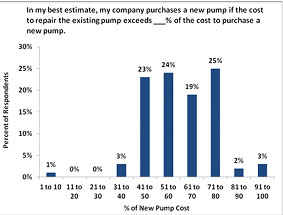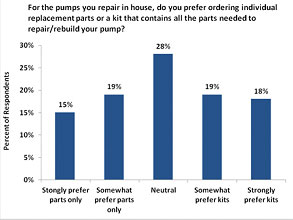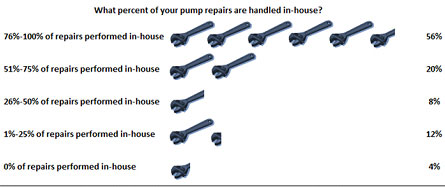Many options are available when pump repair is required.
The word genuine defines something that is real and authentic. In and of itself, the word represents reliability and something worthy of being trusted. Combine genuine with parts, and you have a winning solution in the pump industry.
A genuine part is a warranted replacement part made by the original pump manufacturer. In most cases, genuine parts are the most reliable and highest quality parts available in the marketplace. When a pump needs to be repaired, purchasing genuine parts from the original pump manufacturer is a logical solution.
 When drivers need to make a repair to their vehicle, they are presented with two options commonly used in the automotive industry: purchase genuine parts, or purchase aftermarket parts. Although the automotive industry has had much success with their genuine parts programs, many consumers choose aftermarket parts because of the lower cost. When an end users invest in an air operated double diaphragm (AODD) pump or a rotary positive displacement pump (PD), they are presented with the same option of selecting genuine parts or aftermarket parts.
When drivers need to make a repair to their vehicle, they are presented with two options commonly used in the automotive industry: purchase genuine parts, or purchase aftermarket parts. Although the automotive industry has had much success with their genuine parts programs, many consumers choose aftermarket parts because of the lower cost. When an end users invest in an air operated double diaphragm (AODD) pump or a rotary positive displacement pump (PD), they are presented with the same option of selecting genuine parts or aftermarket parts.
By going directly to the manufacturer to get the genuine parts and service kits, end users will know they are an exact match to the parts with which the pump was built. Genuine parts also offer peace of mind by providing quality assurance and performance guarantees. This option ensures that the pump remains covered by the manufacturer’s warranty (the length of warranty will vary per manufacturer), which is not the case if the repair is made with an aftermarket part.
A viable alternative to genuine parts is aftermarket parts. What exactly is an aftermarket part? Aftermarket parts are made by companies other than the original manufacturer. The quality can range anywhere from good to poor. Aftermarket parts can be more affordable, and some companies, have a wide product offering. A word of warning, some aftermarket parts may void the manufacturer’s warranty.
 Genuine parts or aftermarket parts? The choice is yours, and it will be based on the current circumstances. The bottom line is that all aftermarket parts are not created equal, but all genuine parts are.
Genuine parts or aftermarket parts? The choice is yours, and it will be based on the current circumstances. The bottom line is that all aftermarket parts are not created equal, but all genuine parts are.
Repair Versus Replace
Should an end user’s AODD or PD pump fail, he may be inclined to simply replace the unit all together. However, if not financially prepared to do that, the end user could consider a repair versus replace options.
Because a pump is old does not mean it needs to be replaced. Many pumps are designed to be easily repairable by experienced pump maintenance personnel. Many pumps have a functional life of thirty or more years, but pump life is totally dependent on the application, the pump system and how it is operated and maintained.
The decision to repair or replace is based primarily on a cost comparison between the two alternatives, but other factors also need to be considered—such as budgets, maintenance workload, the application duty and the need for spares on the shelf. Does an end user include the cost of maintenance labor in the evaluation? Do end users rebuild on-site, or send pumps out to be repaired? Do they sell scrap, or have to pay for disposal?
Each facility is different. Figures 1, 2 and 3 are results of a survey of more than 100 industrial pump users, asking at what level of cost do they repair a pump versus replace it (Figure 1); how they normally do pump repairs, in-house versus outside (Figure 2); and their preferences on individual parts versus repair kits (Figure 3).
Do a facility’s pump maintenance practices and preferences look like those shown in Figures 1 through 3? The decision to repair or replace is made on a case-by-case basis, but with  the tools, parts, kits and expertise available from original manufacturers and local stocking distributors, end users will find rebuilding pumps is normally a cost-effective way to keep processes operating efficiently.
the tools, parts, kits and expertise available from original manufacturers and local stocking distributors, end users will find rebuilding pumps is normally a cost-effective way to keep processes operating efficiently.
Conveniently Packaged Service Kits
Should an end user make the decision to repair, it is good to know that some manufacturers now have complete service kits to save money and time. The kits include all the parts needed to make a typical pump repair, conveniently packaged. End users order one part number and receive all the parts for the repair. These kits offer the flexibility to use one or all of the components at the same time. Some companies are making it easy to quickly identify the specific kits needed by putting this information directly on the pump name plate.
Whether a genuine part is needed, an aftermarket part is searched for or perhaps a conveniently packaged service kit to make a pump repair is required, many manufacturers are making it easier to find exactly what is needed. For more information, end users should contact their preferred manufacturer or local distributor.
Pumps & Systems, February 2012


